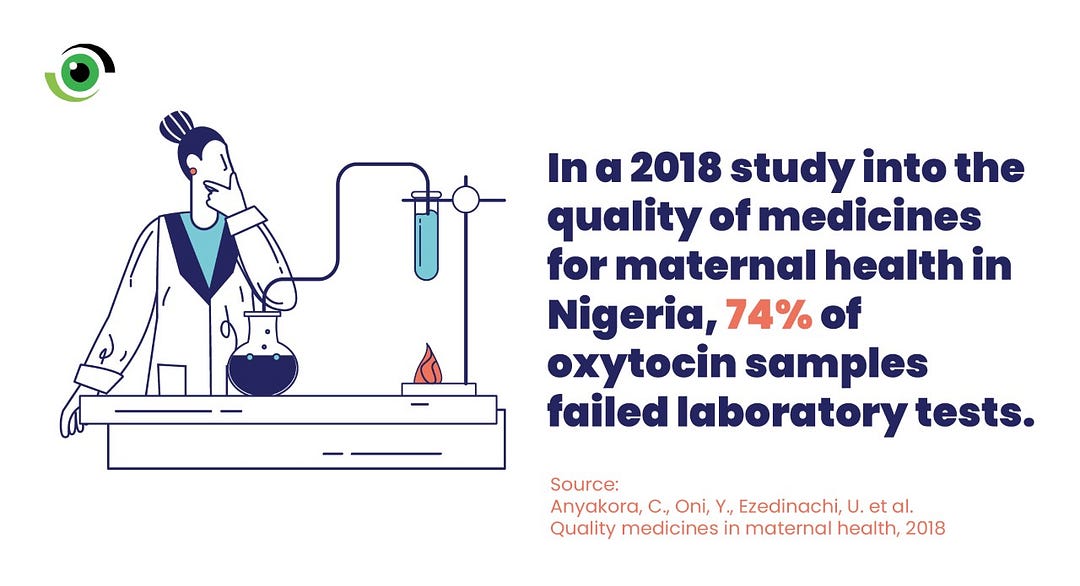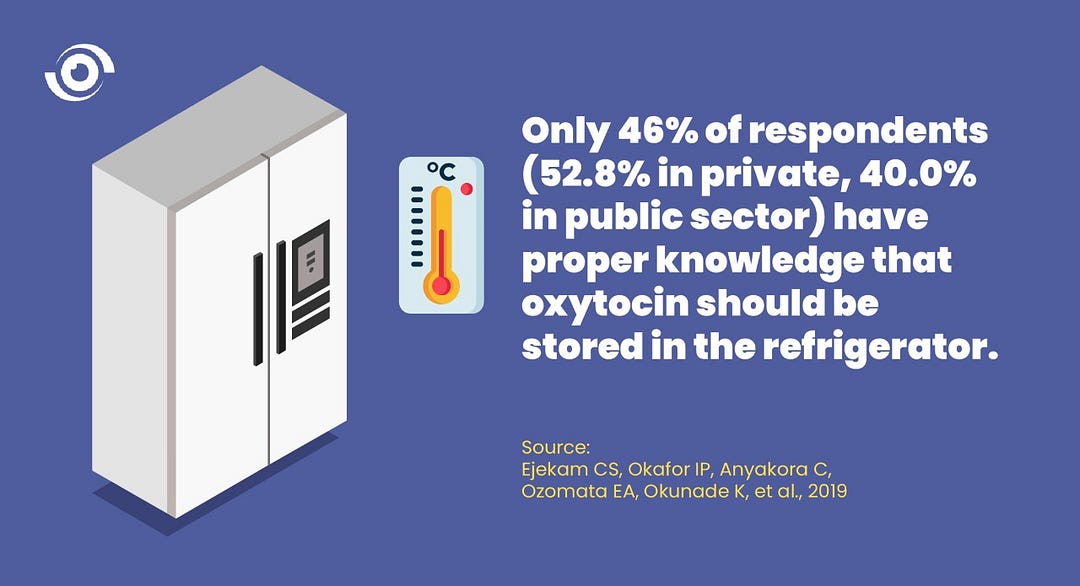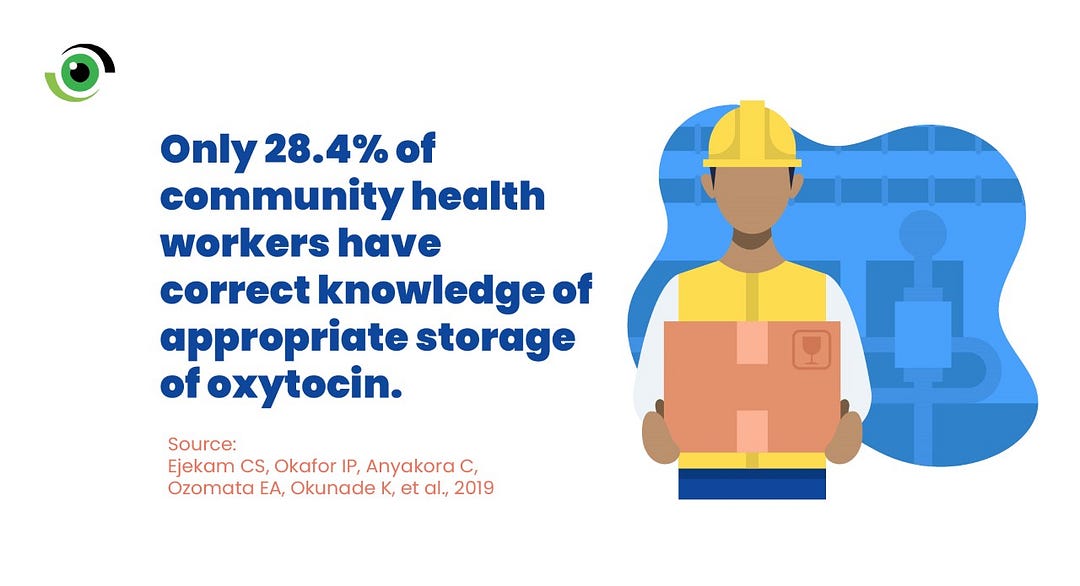By Chioma S. Ejekam, University of Lagos and Chimezie Anyakora, Pan Atlantic University
Severe bleeding after childbirth — postpartum haemorrhage — is a leading cause of maternal morbidity and mortality in middle-income countries. Oxytocin is an affordable and effective drug that’s recommended to prevent postpartum haemorrhage.
But there are concerns about the quality of oxytocin available for use by healthcare workers in most low- and middle-income countries, including Nigeria.
Oxytocin requires cold chain supply from the point of manufacture to the point of use for it to maintain its effectiveness. But most facilities in low- and middle-income countries, especially those at the primary healthcare level, have no refrigerators or reliable electricity supply.
A 2018 study looked into the quality of medicines for maternal health in Nigeria. It reported that 74% of oxytocin samples failed laboratory tests. This means there was a high prevalence of substandard oxytocin available in the country.

There is growing evidence that when poor-quality oxytocin is used, it fails to prevent post-partum haemorrhage. Poor-quality medicines may be an unaccounted root cause of high maternal mortality in low- and middle-income countries. But healthcare providers often do not suspect this. As a result, they do not document or discuss the poor quality of medicine.
Another concern is the apparent lack of adequate knowledge around oxytocin among healthcare providers. A pilot study in Lagos assessed the knowledge and use of oxytocin among 705 doctors and nurses. It found that only 52% of the respondents knew oxytocin should be stored at 2˚C to 8˚C — and 41% used double the recommended dose. Only about 13% of respondents reported they had used an ineffective brand of oxytocin and of this, just 12% had the needed pharmacovigilance form in their health facilities to report the ineffectiveness.
We then expanded the Lagos study to get a broader picture. The national study selected 12 states and a sample of 6,299 healthcare workers (including doctors, nurses, midwives and community health workers). The study assessed their knowledge, use, storage practices and perceived quality of oxytocin used for prevention of post-partum haemorrhage. We found significant gaps in knowledge of best practice and this could endanger the lives of women giving birth.
Our findings should be used to establish clinical guidelines and training. Healthcare providers need to improve their knowledge, storage practices and use to safeguard the quality of these lifesaving medicines.
Lack of knowledge
In our study only 46% of respondents (52.8% in private, 40.0% in public sector) had proper knowledge that oxytocin should be stored in the refrigerator. The healthcare workers in the private sector had better knowledge compared to the public sector. Those with more than 10 years in practice had better knowledge compared to those with fewer than 10 years in practice. But only 34% reported that they actually stored oxytocin in the refrigerator in their facilities (in practice).

The dose of oxytocin recommended by the WHO for the prevention of post-partum haemorrhage is 10IU. About 5% of the respondents used a dose of 15IU. And 41% used double or more the recommended dose. Among the respondents, 23% reported experiencing the failure of oxytocin to prevent bleeding after delivery.
The task shifting and sharing policy of Nigeria has allowed community health workers to take on some of the tasks of more trained providers, including the use of oxytocin. Community health workers used oxytocin more than doctors and nurse or midwives.
The findings from our study showed that oxytocin is most frequently (77%) administered via intravenous infusion. Most community health workers do not have the requisite skill to administer intravenous medications. Yet they are the ones who most often use the oxytocin. In addition, community health workers had the least knowledge of appropriate storage of the medicine — only 28.4% had correct knowledge.

Community health workers should receive adequate and continuous training to give them a clear understanding of how to store oxytocin, when and how to use it, in addition to knowing the limit of their responsibilities.
Recommended practice for reporting lack of medicine efficacy is that health workers should document and report cases of treatments not working. But our findings showed that health workers do not suspect poor quality of oxytocin and consequently do not report it. They keep increasing the dose until they achieve the desired contraction to stop the bleeding. Only one in three respondents documented perceived ineffectiveness of the oxytocin used. Of these, just 4.6% documented it through the correct channel — pharmacovigilance form, this is similar to the findings of the Lagos study. So quality issues were not being raised.
Going forward
Beyond developing clinical guidelines and regulation on the use of oxytocin, there is a need to continuously train healthcare providers — especially nurses, midwives and community healthcare workers. This is the critical first step needed to create awareness and ensure adherence to the recommended standards for oxytocin dosage, storage along the supply chain, quality concerns, and the appropriate actions when oxytocin fails to prevent post-partum haemorrhage. Training is also needed to improve reporting of therapeutic ineffectiveness.
The healthcare providers who help deliver babies are in the best position to unveil quality concerns of the medicines they use. They are at the end of the supply chain and logistics management of medicines.
This study also shows that key stakeholders (medicine regulators and all players along the medicine supply chain, up to the health facility management) should take urgent action on the management of the cold chain.
Governments must provide alternative sources of energy to ensure availability of electricity especially in remote public health facilities.
Final considerations could be the use of other medicines that are more suitable for the Nigerian climate and conditions. In 2018 the WHO recommended the use of carbetocin (heat-stable formulation) as an alternative for postpartum haemorrhage prevention. The Nigerian government should encourage the availability of this alternative. Manufacturers could also consider the development of oxytocin with alternative routes of administration for ease of use among non-highly skilled health workers.
Chioma S. Ejekam, Consultant Public Health Physician, University of Lagos and Chimezie Anyakora, Professor, Pan Atlantic University
This article is republished from The Conversation under a Creative Commons license. Read the original article.



One opportunity to explore is to leverage the immunization cold chain infrastructure to help guarantee quality of the oxytocin. Most of our vaccines are stored at this required temperature. Cold chain officers at the local government level are skilled enough to provide hands on training on storage and use. There are close to 8K health facilities across the cou try with solar drive refrigerators that can support this.
The opportunity to leverage existing infrastructure and know-how in cold chain is a well noted point. Given the repeated challenges with poor quality oxytocin, including health worker knowledge, it is clear as evidenced by the paper written by Dr Ejekam and Dr. Anyakora that alternative uterotonics that do not depend on a cold chain, but are heat stable should be explored (in line with existing WHO guidelines).